Florida Turtles Identification Guide (With Pictures & Charts)
Ah, Florida, the Sunshine State. Famous for sunny, sandy beaches, ferocious alligators, Florida Man, active nightlife, elusive panthers, and, of course, the one and only Everglades ecosystem.
Since this peninsular state is almost 20% covered in water, it probably won’t surprise you to hear that many, many turtles call this state home – over 30 species, to be precise!
With such a vast diversity to discover, let’s not waste time – let’s introduce you to Florida’s turtles!
Table of Contents
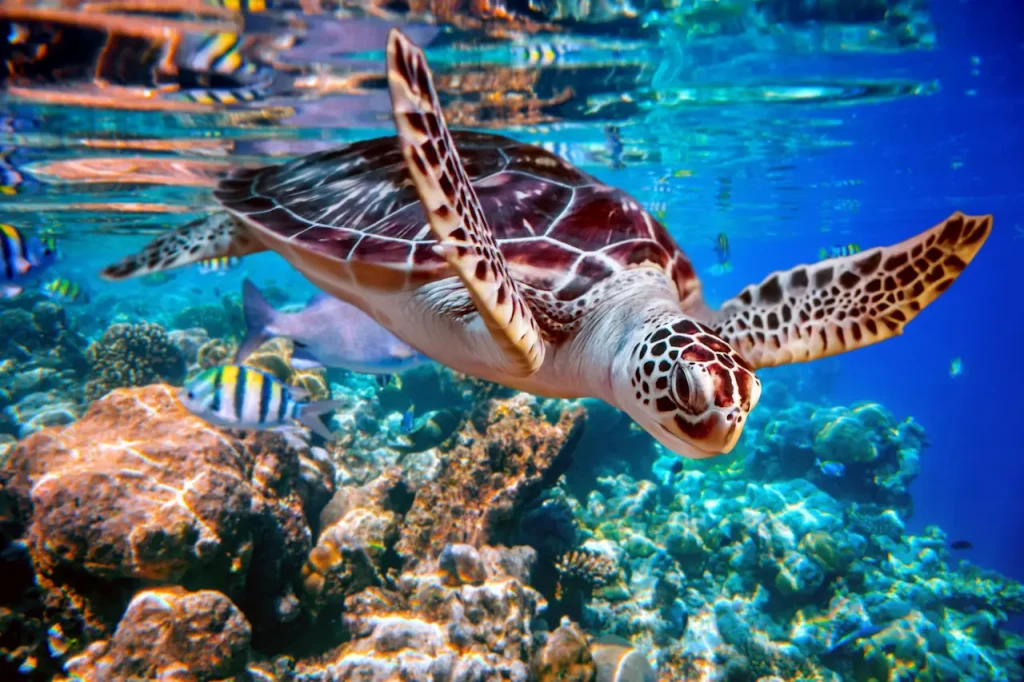
Softshell Turtles (Trionychidae)
The Trionychidae family of turtles are named after their leathery, flat shells that lack boney scutes.
While the absence of a heavy, armoured shell may leave softshell turtles physically vulnerable to predators, it also enables them to flee faster than other turtles.
Florida Softshell (Apalone ferox)
The Florida softshell is found throughout the entire state of Florida, and the southern regions of South Carolina, Georgia, and Alabama.
This is the largest softshell turtle species in North America, averaging at 6 to 30 inches and 6 to 15 pounds.
Florida softshell turtles may be differentiated from other Florida-native softshells by their very dark brown or olive green carapace (upper shell).
Gulf Coast Spiny Softshell (Apalone spinifera aspera)
A subspecies of the spiny softshell (Apalone spinifera), the Gulf Coast spiny softshell is endemic to the Carolinas, Alabama, and northern Florida.
They have two or more black lines bordering the rear end of their carapace, and they’re covered in ring-shaped spots.
Gulf Coast Smooth Softshell (Apalone mutica calvata)
The Gulf Coast smooth softshell is also native to the panhandle of northern Florida and southern Alabama.
They have no spines, and the spots on their carapace are barely visible due to their darker-colored shell.
Snapping Turtles (Chelydridae)
Snapping turtles are famously named after their propensity and ability to snap their powerful jaws onto prey or perceived threats.
While they’re flawlessly designed to lure and hunt live prey, snapping turtles are also happy to eat carrion and animal matter.
It’s unknown how long snapping turtles live in the wild, but the suggested maximum age is well over one-hundred years.
They don’t reach sexual maturity until at least twelve years of age.
Common Snapping Turtle (Chelydra serpentina)
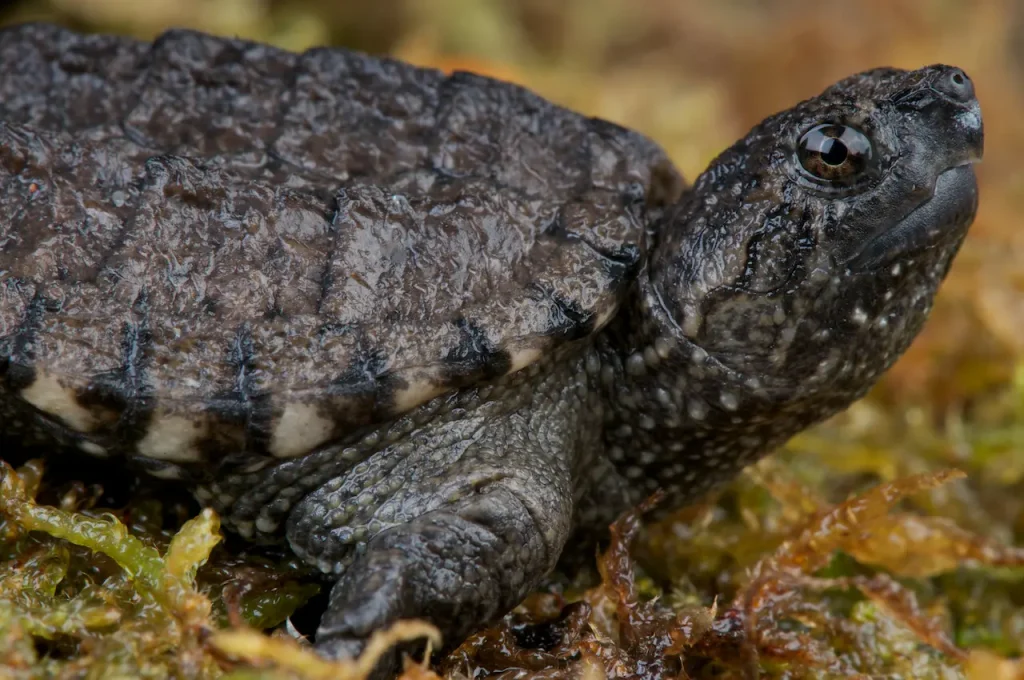
The common snapping turtle can be found in Florida, as well as most of the United States.
The Florida snapping turtle (Chelydra serpentina osceola) is a formerly-recognized subspecies that are no longer classified separately.
Weighing in at 10 to over 30 pounds, they may be large compared to other turtles, but Florida’s other snapping turtle dwarfs them.
Alligator Snapping Turtle (Macrochelys temminckii)
The alligator snapping turtle takes the prehistoric snapping turtle look to a whole new level.
Their shells are covered in huge, spiky osteoderms.
Their blocky head features an impressively sharp beak, eyes surrounded by yellow patterns, and a bright tongue for caudal luring.
The largest, verifiable individual weighed in at 249 pounds, but wild adults typically weigh 19 to 176 pounds.
Suwannee snapping turtle (Macrochelys suwanniensis)
The Suwannee snapping turtle is a newly described species separate from, but closely related to, the Alligator Snapping Turtle (Macrochelys temminckii).
They live in the Suwannee River, which runs from southern George to north-central Florida.
Pond Turtles (Emydidae)
The taxonomic family Emydidae is one of the largest families of turtles in the Western Hemisphere.
They’re also known as terrapins, pond turtles, or marsh turtles. The family includes roughly fifty turtle species, and around twenty of those species are native to Florida.
Their behavior is more terrestrial than our previously-discussed softshell turtles and snapping turtles.
Spotted Turtle (Clemmys guttata)
The spotted turtle is the only species in the genus Clemmys. It is small, averaging between 3 and 5 inches.
In addition to northern and central Florida, this species can be found throughout much of the East Coast in the United States and areas surrounding the Great Lakes.
They’re dark gray or black with small yellow spots on their skin and shell.
Chicken Turtles (Deirochelys reticularia)
The Florida chicken turtle (Deirochelys reticularia chrysea) and the Eastern chicken turtle (Deirochelys reticularia reticularia) are two subspecies of chicken turtle that are native to Florida.
They’re named after the taste of their meat.
These turtles are similar in appearance to painted turtles, sliders, and many other pond turtles. However, its striped neck is unusually long, and its shell features a net-like pattern.
Barbour’s Map Turtle (Graptemys barbouri)
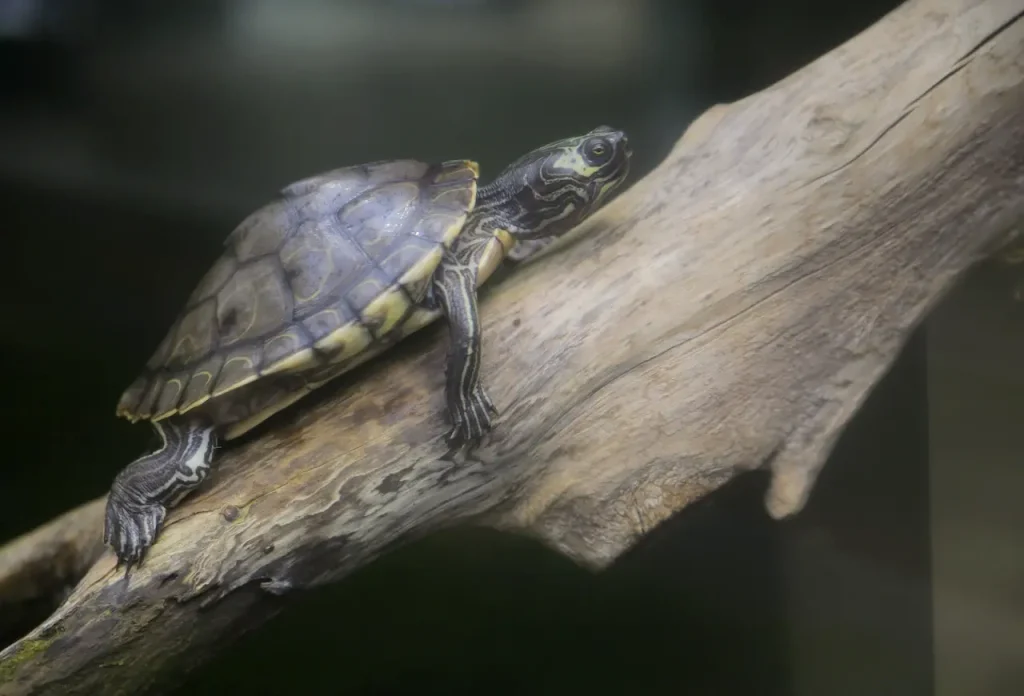
The Barbour’s map turtle is the only map turtle native to Florida.
Its limited range also includes areas of southeastern Alabama and southwestern Georgia. At 3 to 11 inches, it’s the largest species of map turtle.
The gray carapace has four curved spikes along the center. They eat primarily mollusks and insects and frequent fast-flowing bodies of water.
Cooters (Pseudemys sp.)
Several species of cooter call Florida home, too.
They have a dark-colored carapace with light brown, intricate markings and a yellow or orange plastron.
These turtles enjoy hauling out completely to bask on rocks and large logs, or even alligators!
Cooters aren’t picky – they’re omnivores, happy to scavenge, forage, and hunt.
Here are the currently recognized species and subspecies you can find in the sunshine state:
- River Cooter (Pseudemys concinna)
- Florida Cooter (Pseudemys concinna floridana)
- Suwannee Cooter (Pseudemys concinna suwanniensis)
- Florida Red-bellied Cooter (Pseudemys nelsoni)
- Peninsula Cooter (Pseudemys peninsularis)
Sliders (Trachemys sp.)
Sliders are also common in Florida, as they are common in much of North America.
Red-eared sliders (Trachemys scripta elegans), while prevalent, are actually an invasive species in Florida. They compete for resources with the native cooters mentioned above.
These invaders’ most distinguishing characteristic is the bright red stripes running from the corner of their eyes down their necks.
Their closely-related cousins, yellowbelly sliders (Trachemys scripta scripta), occur naturally in north Florida and can be identified by the thick, yellow stripes on their skin and a lack of red markings.
Diamondback Terrapins (Malaclemys terrapin)
The state of Florida is home to four threatened subspecies of diamondback terrapin:
- Caroina Diamondback Terrapin (Malaclemys terrapin centrata)
- Ornate Diamondback Terrapin (Malaclemys terrapin macrospilota)
- Mangrove Diamondback Terrapin (Malaclemys terrapin rhizophorarum)
- Eastern Florida Diamondback Terrapin (Malaclemys terrapin tequesta)
This species is unique in its preference for brackish, coastal waters.
Their breathtaking colors and patterns have driven their popularity as pets, and their meat was once considered a delicacy.
Over-collection from wild populations nearly drove them to extinction. Luckily, there are now laws in place to protect them.
The name diamondback terrapin refers to the diamond-like yellow pattern on their brown or gray shell.
Their skin is typically light gray with wriggly or spotty black markings.
Box Turtles (Terrapene carolina)
Last, but certainly not least, in the Emydidae family are the box turtles. Four subspecies of the common box turtle live in the sunshine state:
- Florida Box Turtle (Terrapene carolina bauri)
- Eastern Box Turtle (Terrapene carolina carolina)
- Gulf Coast Box Turtle (Terrapene carolina major)
- Three-toed Box Turtle (Terrapene carolina triunguis)
Box turtles are unique among other members of this taxonomic family because they are almost exclusively terrestrial, and they don’t have the webbed toes that are characteristic of many other related species.
They have a highly domed, brown, or gray shell with beautiful yellow stripes. Box turtles can completely withdraw themselves into and close their hinged shell.
Mud and Musk Turtles (Taxonomic Family Kinosternidae)
Turtles in the Kinosternidae family are small, mostly aquatic turtles. Their diet is primarily carnivorous, consisting of crustaceans, insects, mollusks, fish, and amphibians.
Mud Turtles (Kinosternon sp.)
Mud turtles are the smaller of these two groups in Florida.
Both the Striped Mud Turtle (Kinosternon baurii) and the Eastern Mud Turtle (Kinosternon subrubrum) are endemic to the sunshine state.
Striped mud turtles have three light-colored stripes along the length of their shell and can also be found in Georgia, the Carolinas, and Virginia.
Eastern mud turtles have an even wider range, spanning most of the eastern United States, and have a monotone, dull brown carapace.
Musk Turtles (Sternotherus sp.)
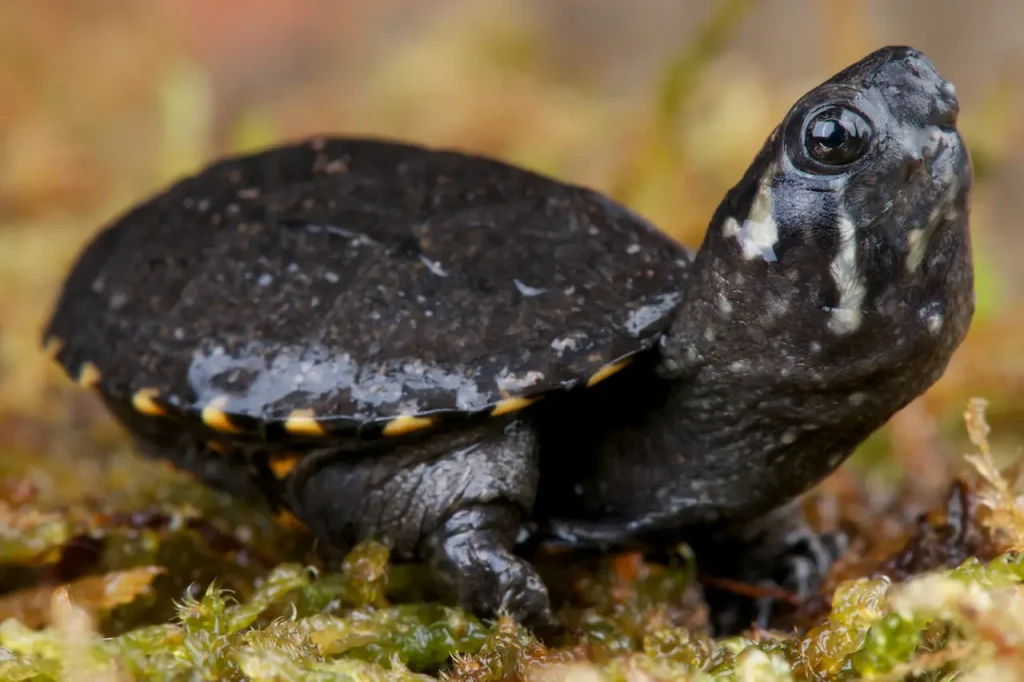
Musk turtles are larger and feature a more domed, monotone brown carapace than their “muddy” cousins.
They’re named after their ability to release a foul-smelling liquid as a means of self-defense.
Three species of musk turtle inhabit Florida:
- Loggerhead Musk Turtle (Sternotherus minor), limited to the northern portion of Florida and the southeastern United States.
- Stripeneck Musk Turtle (Sternotherus peltifer), limited to the northern portion of Florida and the southeastern United States.
- Eastern Musk Turtle (Sternotherus odoratus), found across Florida and much of the eastern United States.
Tortoises (Testudinidae)
Being that they are so closely associated with dry land and even arid deserts, it may surprise you to find out that Florida is, in fact, home to one tortoise species!
Gopher Tortoise (Gopherus polyphemus)
The gopher tortoise is a species of fossorial (burrow-dwelling) tortoise native to most of Florida and the southern portions of South Carolina, Georgia, Alabama, Mississippi, and Louisiana.
They are a keystone species, imperative to the survival of at least 360 other species that utilize their vast burrows.
They are classified as vulnerable by the IUCN, with their biggest threats being human-oriented: habitat loss caused by development, wild harvesting for the pet trade and meat, and relocation-caused fatalities.
As the only tortoise in Florida, they’re relatively easy to identify: elephant-like feet, thick and heavily-keeled dry scales, and a dull brown shell.
Gopher tortoises are small, as far as tortoises go, typically only reaching around 8 to 10 pounds.
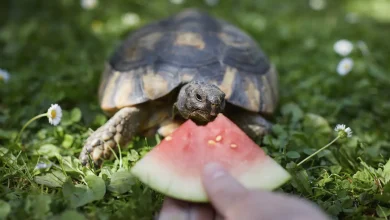
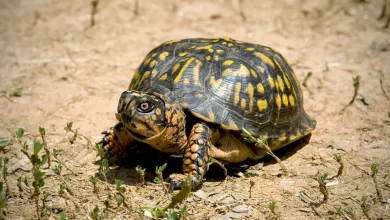
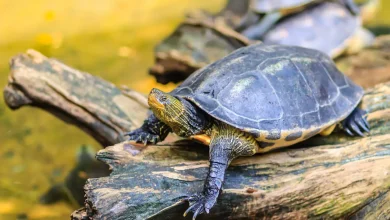
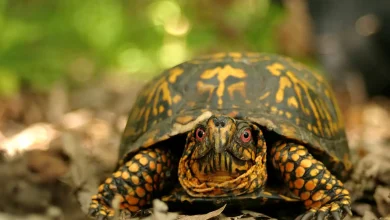
Turtle just laid eggs on my lawn. I would like to protect these eggs from predators fire ants etc. How do I best do this. I thought of placing them in a large flower pot covering it with earth and keeping it slightly moist. I’m having trouble identifying the turtle to see how long its gestation is. Can anybody help me. Jill. Ft myers
Florida Softshell (Apalone ferox) Laid some eggs in the field behind our home.. how long does it take to hatch?
When we visited Florida in 2019 I took photos of a turtle laying its eggs in Wakulla Springs State Park. Yet I can’t seem to identify the species, since it was quite a large turtle with a very dark smooth back and no apparent yellow or red marks…
What kind might that have been?
maybe a gopher tortoise
I have a turtle who showed up yesterday and today looks like it may be making a nest in my yard
Army green all over small head and burrowing into leaves and sand about 10 inches long and 8 inches wide. Can you tell me if it’s safe to leave it there. It’s right next to my pool enclosure